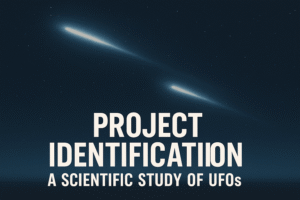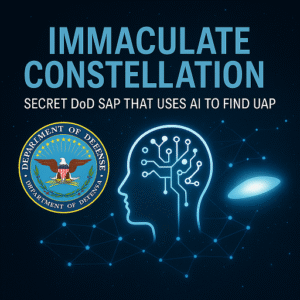In the annals of UFO research, Project Identification stands out as one of the rare attempts to approach the mystery with a disciplined, instrumented, multi-witness methodology. Spearheaded in the 1970s by physicist Dr. Harley D. Rutledge, the project sought to observe, quantify, and perhaps even interact with anomalous aerial phenomena while they were happening—not after the fact.
What follows is a look at how the project was conceived, who ran it, the experiments and observations made, and the provocative conclusions Rutledge drew—some of which still stir debate in the UFO/UAP community today.
Origins, Motivation & Leadership
In 1973, reports spread through Piedmont, Missouri, of strange lights performing erratic movements in the night skies. Witnesses included residents, police officers, and pilots—many of whom were confused or frightened.
Rutledge, then chair of the Physics Department at Southeast Missouri State University, stepped in not as a believer, but as a scientist determined to take the matter seriously. His goal was to test whether UFO phenomena could be studied using instruments rather than anecdotes.
Thus, Project Identification was launched in April 1973, aiming to observe UFOs under controlled conditions with multiple witnesses and instruments. Rutledge’s team used telescopes, radio receivers, electromagnetic detectors, and even theodolites to track the lights. His results were later published in Project Identification: The First Scientific Field Study of UFO Phenomena (1981).
Rutledge’s academic pedigree—a PhD in solid-state physics from the University of Missouri—gave the study a legitimacy few UFO researchers had managed before. His approach mirrored what we’d now call a citizen science UAP investigation, though decades ahead of its time.
The Experimental Setup & Methodology
Unlike most UFO research of the era, which relied on after-the-fact witness reports, Rutledge’s team went into the field as sightings occurred. Their methodology included:
-
Multiple observers stationed at separate vantage points to enable triangulation.
-
Theodolites to measure angular motion and estimate speed, direction, and altitude.
-
Telescopes and cameras to capture light dynamics, shape, and color changes.
-
Radio and electromagnetic detectors to monitor for interference or field anomalies.
-
Signaling experiments, including flashing lights or movement patterns to test for apparent “responses.”
While many nights yielded no results, the team eventually logged hundreds of events over several years. Some appeared to exhibit reactive behavior—changing position or flashing back in response to observer signals. Rutledge even documented one case of residue left on lenses after a sighting, later referenced by the Anomaly Archives.
Major Findings & Controversial Observations
Responsive or “Intelligent” Behavior
Several of Rutledge’s recorded cases suggested interaction between the lights and the observers. When team members flashed lights, the phenomena often flashed back in perfect rhythm—too precise to dismiss as coincidence. Rutledge noted that the objects sometimes seemed to anticipate observer movement, turning or pausing as instruments were adjusted.
While he stopped short of declaring extraterrestrial origin, he did use terms like “interaction,” “response,” and “control,” suggesting intelligence behind the phenomena.
Unusual Motion & Flight Characteristics
Objects were seen accelerating instantaneously, making sharp right-angle turns, and stopping mid-air—all movements that defy known aircraft capabilities. In several triangulated cases, speeds were estimated in the thousands of miles per hour, though Rutledge acknowledged large error margins.
Descriptions ranged from glowing orbs and discs to clusters of lights that merged or separated. Many vanished instantly—without a fade or visible retreat.
Electromagnetic Disturbances
At times, radio equipment produced bursts of static when a UFO was visible. Rutledge also logged fluctuations in magnetic readings that coincided with visual events, hinting at a measurable energy component.
Interpretation, Speculation & Limits
By the project’s end, Rutledge reported dozens of high-quality, cross-verified sightings that resisted simple explanation. Still, he remained conservative: most reports were attributed to natural or human causes.
His most daring idea was that consciousness itself might play a role—that there could be a psychophysical link between the observer and the phenomenon. While he avoided the word “telepathy,” his descriptions implied some kind of feedback or awareness.
He concluded only that “something real” was occurring, and that physics as then known could not account for it.
For primary materials and references, see Center for Inquiry’s archive summary and the Anomaly Archives.
Strengths & Weaknesses
What Project Identification Got Right
-
Conducted real-time, instrumented observation rather than secondhand interviews.
-
Used multiple witnesses and triangulation to validate data.
-
Maintained cautious, evidence-driven conclusions.
-
Introduced early thinking about mind–phenomenon interaction, foreshadowing later consciousness-linked UAP theories.
Where It Fell Short
-
Data were prone to wide margins of error.
-
Lacked peer review and replication.
-
1970s equipment limited resolution and synchronization.
-
The “consciousness” element, while intriguing, was speculative.
Legacy, Skywatcher Comparisons & Today’s Frustration
Project Identification remains one of the few UFO studies that actually did the fieldwork. Its design—instrumented, multi-observer, interactive—has since inspired modern civilian groups like Skywatcher Project, who now use digital sensors, IR cameras, and data sharing platforms to capture real-time phenomena.
And yet, here we are—half a century later—with better technology, bigger budgets, and the same bloody mystery. We’ve swapped telescopes for smartphones, and film cameras for FLIR, but no one’s pinned down what these things actually are. Just like Rutledge’s team in 1973, today’s observers watch, record, and wonder—still no closer to the truth.

